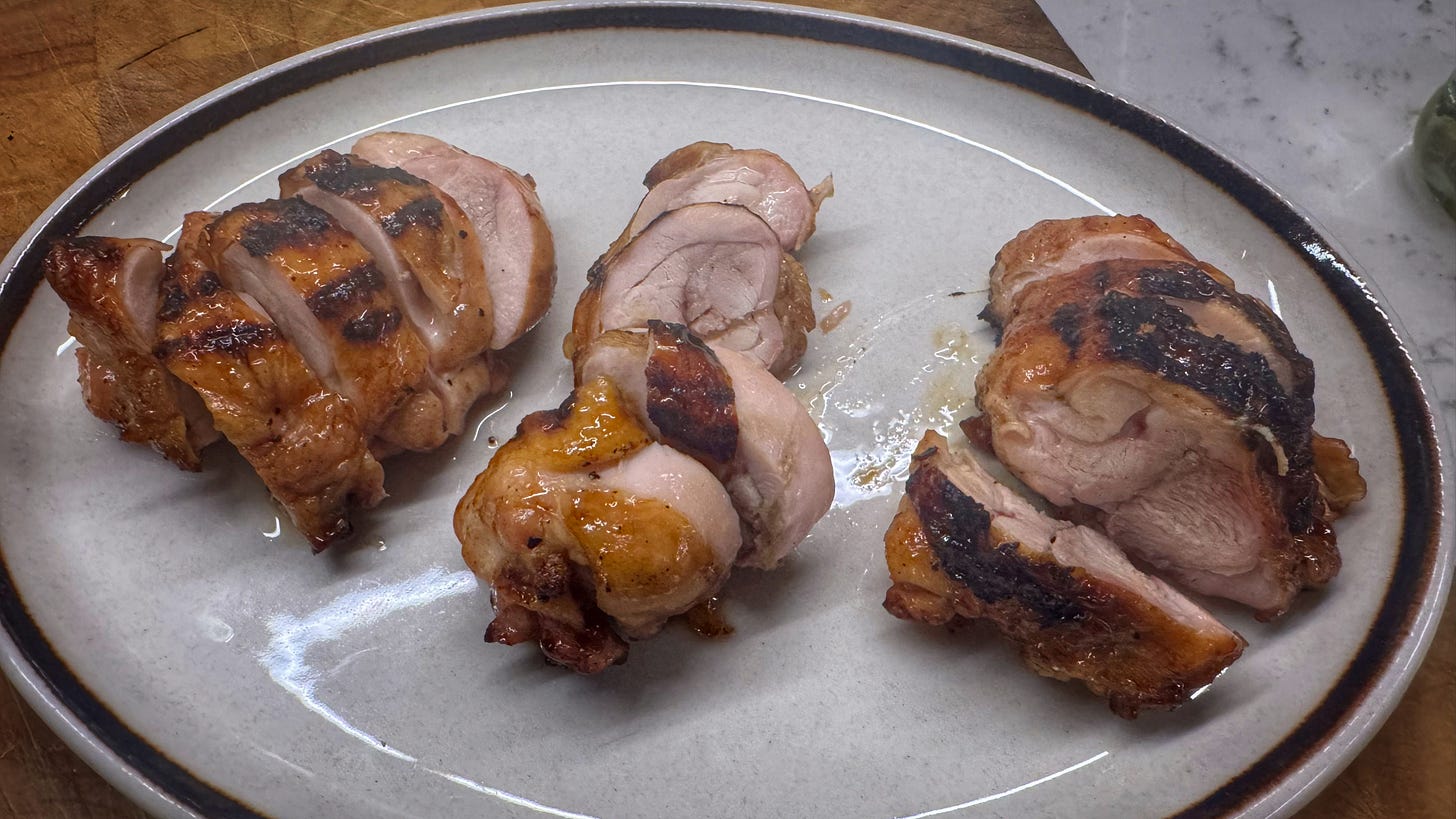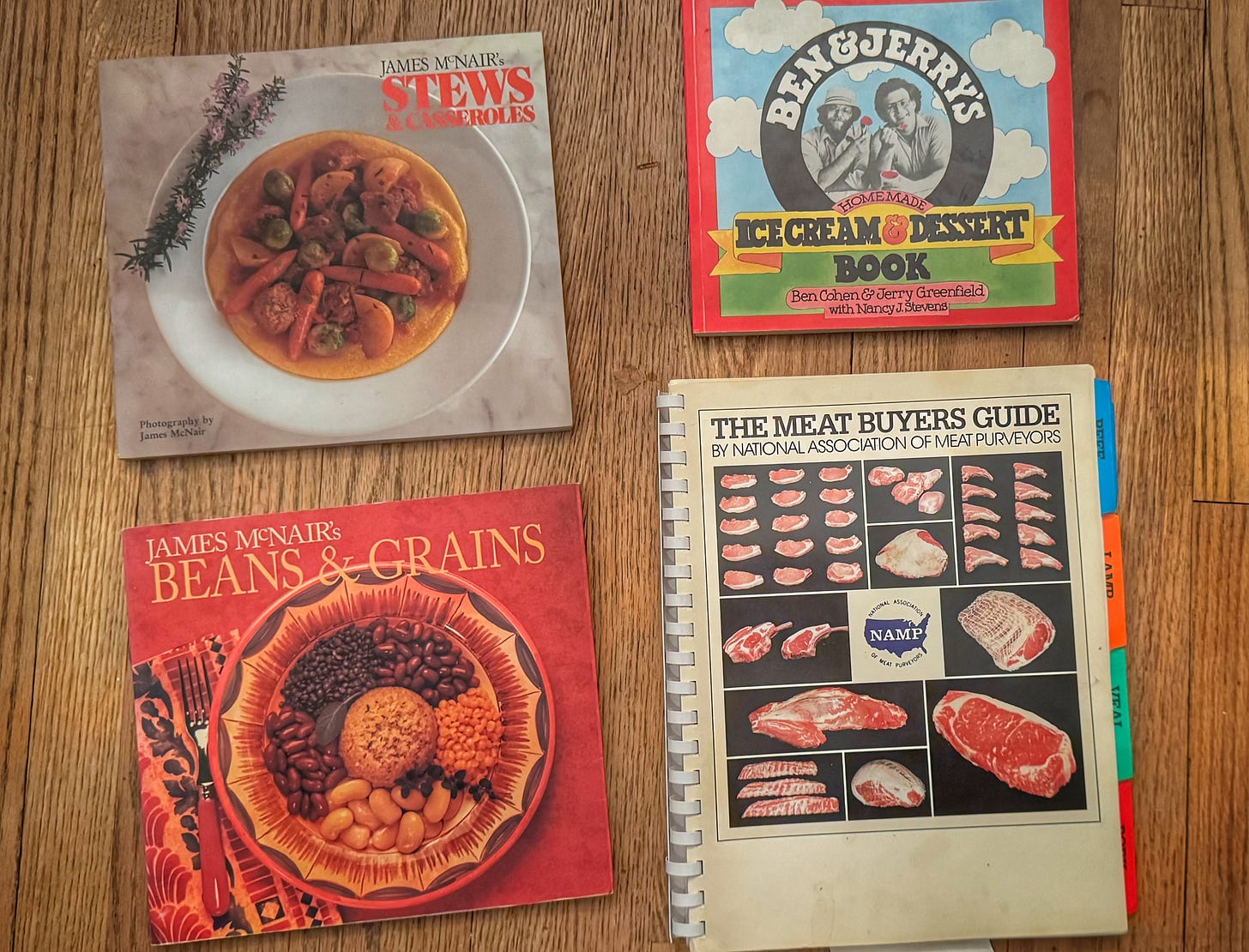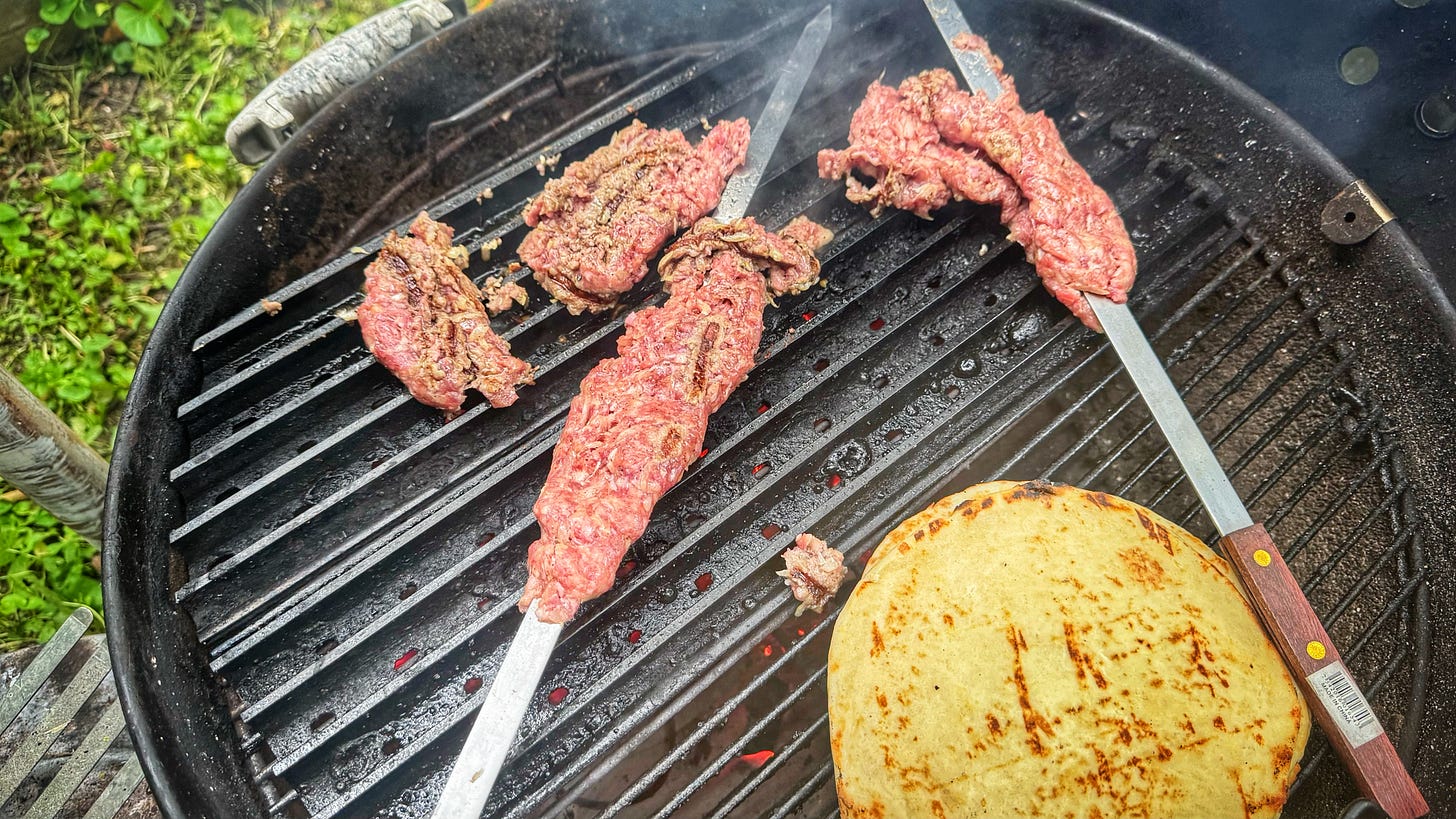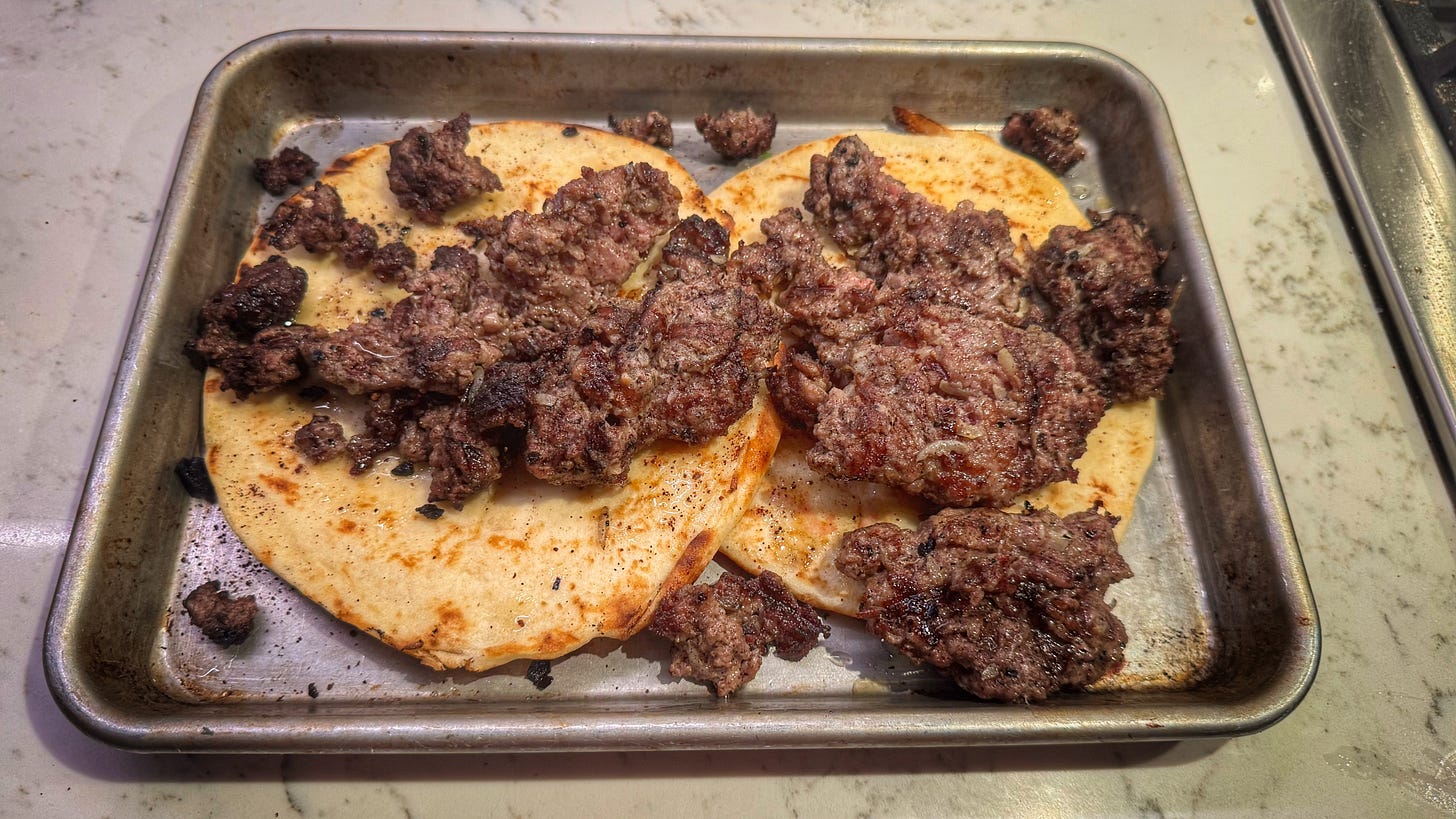64. Sticking it to High Prices
How to feed a crowd affordably
Before I get into this issue proper, I wanted to welcome the unusually large group of new subscribers that have signed up since last time. If you are here for more trade war-related taste tests, you won’t be getting one today. But the next one is in the works. If you follow me on Instagram, (why aren’t you following me on Instagram yet?) you’ll know what it’s going to be about. If you have any suggestions for other products you’d like me to test, reply to this email (if you got it as an email) or leave a comment below.
And now onto the issue.
Kids eat more as they grow up. I know the parents (and probably non-parents) among my readers are rolling their eyes and thinking, “Amazing discovery, Magellan.” But children’s appetites come up in my life at most twice a year and not even that often since the pandemic started. When we held our New Year’s Day open houses, I started to notice this as our friends’ kids left toddlerhood and then single digits behind. First I saw that our small house was suddenly much more crowded. Then what used to be more than enough food was barely just enough.
Since March of 2020 I’ve only had a handful of occasions when I needed to account for kids young adult meals and, as a result, was a bit surprised to discover that they all now have the “eat three baked potatoes at one sitting” appetite I had at their age.
At an annual cottage weekend with friends, we take turns planning and preparing a meal for everyone. Before the pandemic, kids ate earlier with more kid-friendly meals than what we would prepare for the adults. Last summer, with some of them entering their last year of high school, two separate meals didn’t seem necessary or practical.
But what to serve a table that had now expanded to 14 seats? In past years I often favoured large chunks of meat like pork butt or a leg of lamb, grilled in some way. But 14 people + wild inflation + (have I mentioned this before?) a brutal freelance market made buying an even larger chunk of meat unfeasible. As well, my enthusiasm for large chunks of meat has waned in recent years.1
Earlier that summer I had been going through a bit of yakitori mania. I bought the proper skewers and charcoal but rather than splash out for one of the beautiful-but-unaffordable konro grills from Knifewear, I just wrapped some bricks in foil to support my chicken over the coals.
And one thing I learned from this grilled chicken jag—as well as how to load a balanced skewer so it doesn’t roll with the same side always facing down—was that when it’s skewered, I ate far less chicken than I normally would. Often the meat from one thigh—and not a particularly large one—would be enough for me. As explained by the Harvard Medical School, this could be because it forced me to eat more slowly, which gives digestive hormones secreted by the GI tract more time to signal the brain that it’s full.
Knowing this, I had my plan for how to feed 14 without breaking the bank: lots and lots of skewers bearing less meat than would be needed when served as one large hunk. As a bonus, I figured it would take less time to grill small bits of meat instead of the hours it can take to do a roast.2 Satay, with chicken, pork, and beef, was a great choice, with plenty of rice, both cucumber and mango salads, and a huge array of peanut sauces I had bought for a project that never came together. Everyone was happy and full, even though they had consumed a fraction of what I used to serve.
And with grilling season once upon us, I have broken out the skewers again. When I told Beth I had decided to write about them, I warned her that it was about to be Skewer Week for dinner. I planned to make three different kinds to show their versatility: pork marinated in red chile served as tacos, pork satay,3 and my own, less labour-intensive variation on momo (pieces of chicken thigh cooked yakitori-style).
For the red chile skewers, I marinated thin slices of pork shoulder in a blendered sauce of ancho chile powder, lime juice, garlic, olive oil, freshly toasted and coarsely ground cumin, and a tomato I charred under the broiler, setting some aside to serve as a sauce later. Then, with my GrillGrates turned over to the plancha side, I cooked the double-skewered, two-chunk brochettes over a hot fire4 until they were nicely charred on both sides and cooked through, about six minutes in total.
While the pork rested I grilled some zucchini and warmed up the tortillas. A morsel of pork, some guacamole, a small wedge of zucchini, and a dollop of reserved sauce made a fantastic two- or three-bite taco. Using shoulder instead of a leaner cut was a great choice, as the meat didn’t dry out over the coals. I may have had one more than I needed, but since I was only cooking for two, it wasn’t a huge cost overrun.
Two nights later, it was satay time. This time I used a pork chop cut into thin slices that were slightly longer than the red chile pork and marinated in [deep breath] shallot, ginger, garlic, lemongrass, ground cumin and coriander, turmeric, cayenne, fish sauce, lime juice, soy sauce, brown sugar, and coconut milk for about 45 minutes. Satay always seems to be cooked on single skewers with the meat threaded to lie as flat as possible, so that’s what I did. From there, the procedure is much like the red chile skewers, although I decided to flip the GrillGrates over to create some grill lines.
Although the flavour was great, using a leaner pork chop instead of shoulder did lead to dryer meat, especially since it was cut quite thinly. But nothing a dollop of peanut sauce (the one jar I saved from last year’s library of peanut sauces) couldn’t help. And a big helping of Jasmine rice.5 6 And some grilled zucchini because it came in wrapped bundles of five at the supermarket, making Zucchini Week as well.
The final night of what I guess was actually Skewer Half-Week, was an idea I had come up with myself a few weeks before. Yakitori is wonderful, but cutting chicken into small chunks and skewering all of it can, frankly, be a bit of a pain.7 Instead of cutting boneless, skinless thighs, I decided to skewer the whole thighs, rolling them so the skin covered all of the outside, with as little exposed meat as I could manage.8 Because the rolled thighs were much thicker than either of the pork pieces (over one inch vs fractions of an inch), they would take a lot longer to cook, so I built a two-level fire in my grill and cooked them on the cooler side until they were nearly ready.9 During that time, I basted them regularly with yakitori tare, made by simmering shoyu, mirin, rock sugar, sake, and tamari,10 to build up a thin glaze. When the centres of the thighs were almost at 165°F I moved them to the hot side of the grill to crisp the skin, hopefully before too much of the sugar in the tare burnt.
Now for a moment of honesty: the thighs were very unwieldy. The first time I made this a few weeks earlier, I had smaller thighs that were each a little larger than a playing card. They rolled nice and tightly. When I cooked this time to take photographs, my thighs were slightly larger than the palm of my sizeable hands, i.e., much larger than before. Rolling them left spots of meat exposed and overall they were flabby and hard to manage. For aesthetics and for the shorter cooking time, definitely do this with smaller thighs.
The skin crisped and darkened without any unwanted burning. I cut each thigh into chopstick-appropriate chunks closer in size to traditional yakitori chunks.
I went overboard with the sides, grilling zucchini (or course); making cucumbers marinated in rice vinegar, shoyu, and dashi; and putting together gai lan goma-ae (i.e., with a ground sesame dressing) that I totally ripped off from Imanishi Japanese Kitchen earlier in the week.
And rice. Lots of rice to catch all the various sauce and dressing drippings.
There are so many other great skewered foods from around the world. I could have easily done Skewer Month with souvlaki, shish kebab, suya, anticuchos, kofta, Xinjian lamb skewers, and more. What’s your favourite skewered food? Let me know in the comments!
What I’m consuming…
Books! — After striking out a lot at thrifting lately, I finally got on a good run, bagging James McNair’s Beans and Grains and James McNair’s Stews and Casseroles at consecutive stores. They are numbers 18 and 19 in my ongoing quest to collect all 27 of McNair’s pioneering single-subject cookbooks. I also landed a copy of 1987’s Ben & Jerry’s Homemade Ice Cream & Dessert Book, which appears to give away the recipes to some of their big hits like Cherry Garcia and Heath Bar Crunch. I don’t have an ice cream maker, but if I ever get one,11 I’ll be ready. I also picked up a copy of the August 1988 edition of The Meat Buyers Guide by the National Association of Meat Purveyors. It’s full of diagrams and photos of various primal, subprimal, and retail cuts and was only $3, although one recently sold on eBay for $85 US!
One of NYC’s Last Traditional Noodle Masters — I thought baking pizza and bread at home made a floury mess. I had no idea.
What’s on the menu…
Lots of pizza — If it’s grilling season, it’s also backyard pizza season and I’ve been splitting my time between both. After all, I have an absolute ton of tomatoes to use up. I tried out a new version tonight with sweet Italian sausage, sautéed onions, and gai lan cooked in the style of rapini with garlic and olive oil, which I’ve written about before as a wonderful way not to pay rapini prices to American farmers.
It turned out great and I will definitely make it again. What won’t be making another appearance on my pizza is Hunt’s Heirloom Whole Tomatoes, the one canned tomato I couldn’t track down while I was testing. They eventually turned up at Treasure Hunt, a thoroughly depressing and yet fascinating liquidation store I can’t help dipping into when I’m in the area. Appropriate that I found them at a liquidator since they were so watery I had to strain the sauce I made from blending them to make sure my pizza didn’t turn into a puddle. I didn’t need a rubric to figure out how they rated. On a scale of one to ten? A big thumbs down.
Postscript
I realized after I’d finished writing this post that I should have done a recipe with beef as well, perhaps in place of one of the pork recipes. Since this issue wasn’t scheduled to go live for another day, I thought I would use the extra time to make something with beef, specifically kabab koobideh, or Persian ground beef (and sometimes lamb) kebabs. I found what looked like a good recipe online (I won’t name names in this case) and got to work. Initially, as I formed the meat, mixed with grated onion, baking soda,12 and sumac, around the long, flat kabab skewers I had bought years ago and barely used, things were looking promising.13
But as soon as they hit the grill, it was a disaster. The recipe calls for rotating the skewers every 30 seconds at first. This is possible when they are suspended over the fire, like yakitori. But, of course, when they are touching the grill, they will still be very stuck to it after thirty seconds. The meat on the skewers tore and fell off the skewers more each time I tried to turn them.
Eventually I pulled them off the skewers and tried to grill the now quite loose meat on the ridges of my GrillGrates, which is something like trying to cook a pancake on a badminton racquet. I was able to salvage almost all of it and, eaten with naan14 and topped with tahini-lime sauce15 I’d made for some grilled cabbage16 early in the week, it was still very tasty.
Aside from not suspending the skewers over the flame instead of placing them directly on the grill, my big mistake, I learned later, was how gingerly I had handled the beef and onion mixture. When I think of handling ground beef, my mind first turns to burgers, where you want to handle it as little as possible, lest it get tacky and bind together too much, like a sausage would.17 But that’s exactly the point here. In this video, specifically about how to keep koobideh from falling off the skewer, the host says you should mix the beef, onion, and seasonings with your hands for up to seven minutes. (Also, look at how beautiful his shaping of the skewers is in the thumbnail below! Now scroll up and look at mine again. Ugh.))
By the end of those seven minutes, the mixture is tacky and well blended and far more cohesive than my long burgers on a stick ever could be. Deep down, I knew this, but in the rush to get another skewer into this issue, I forgot to consider it. Just another reminder that you often need to rely on your own experience instead of what the recipe tells you to do.
If you like what you’re reading, you probably know someone else who would enjoy it too. Be a pal (to both of us) and share The Plate Cleaner with them!
I can actually mark the date on which that enthusiasm went in to steep decline: Thursday, July 21, 2022. In anticipation of that year’s cottage weekend, I had just started sous-viding 10 pounds of pork that I would finish up north on the grill and pull for sandwiches. Then came the email: one of our hosts had tested positive for COVID (they were otherwise fine) so the weekend was called off. It took some effort and lots of freezer space, but eventually we were able to finish all of the pork. The largest thing I have cooked since then has been a chicken (and often just a Cornish hen at that).
I did not factor how long it would take to skewer enough meat to feed 14. Easily an hour spent elbow-deep in satay marinade. Plan (and dress) accordingly.
Yeah, I know. Two recipes from The New York Times Cooking by the same guy. What can I say? I was lazy. If lazy is making three different skewer recipes for you ingrates! (Foreshadowing: Four!)
Some writers qualify what a “hot” fire is vs. a “medium” fire by stating the number of seconds you can hold your hand 12 inches above the coals before you have to pull it away. My rule of thumb is when you’re spreading out the coals of a hot fire, you’ll smell the residual laundry detergent burning off of your clothes. If you don’t, it’s medium.
Jasmine rice is the third-string rice in our house, behind Japanese and Basmati rices. But every time I make it, I wonder why that is. It’s so wonderfully fragrant. I had meant to make this coconut rice to go with the satay, but totally forgot about it until the rice cooker was already chugging away.
Although it’s definitely worth it sometimes. Smaller chunks means more surface area for the yakitori tare (or sauce) to cling to and caramelize upon.
Prior to skewering the thighs, I salted them and put them on a rack, skin side up in the fridge uncovered so some of the skin’s moisture would be drawn out, leading to more crispiness.
The hotter your cooking temperature, the greater the difference in doneness between the outside and inside of your food will be. Over a hot flame, a steak will be deeply browned and crusted on the outside and the inside will still remain barely warmed and juicy. This is desirable. For chicken, this is called Salmonella. Because chicken needs to be cooked uniformly all the way through, it’s better started over gentler heat and finished over high heat to brown and crisp the outside once it’s almost finished.
The recipe I used is from my old trusty copy of Shizuo Tsuji’s Japanese Cooking: A Simple Art. I started in on it not realizing that it made three-and-a-half cups of tare. I’m set for tare for the next nine months.
If you’d like to give me one as a gift, I’ll have one of these, please.
As well as adding seasoning (of which there could have been more, tbh), baking soda also makes the meat mix puff slightly when cooked, similar to the baking powder used in the Vietnamese grilled sausages I wrote about here.
When I looked at other photos of kebab koobideh after I’d made it, I realized that mine in fact looked terrible. They lacked the graceful scalloped surface of the real thing. Mine were also so wide that the weight of their overhang alone would have pulled them from the skewers.
The recipe called for lavash, a thin flatbread. Supermarket #1 had only bougie $8 lavash. It also had pita, but I figured Supermarket #2 would have pita as well and possibly for less. Supermarket #2 had neither, but it had naan. So naan it was.
Here’s the recipe, stir some lime juice into some tahini until it’s just a little too acidic. It will probably be too thick to pour, so thin it out with some ice water until it’s the consistency and acidity you want. Then add salt to taste. Good on almost anything grilled.
Here’s the recipe: Cut cabbage into eight wedges. Brush the surfaces with oil and season with salt and pepper. Grill over moderate heat until the centre has begun to soften and the outsides are nicely charred.
















This was hugely inspiring Mike, and a super read as well. I might have to break out the charcoal this weekend!! Thank you!